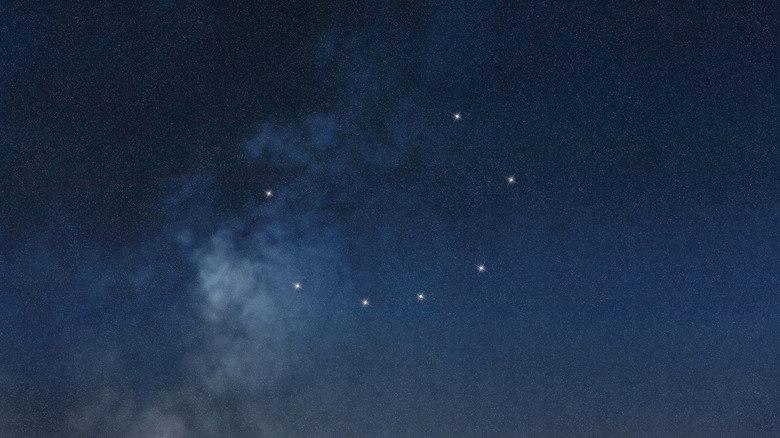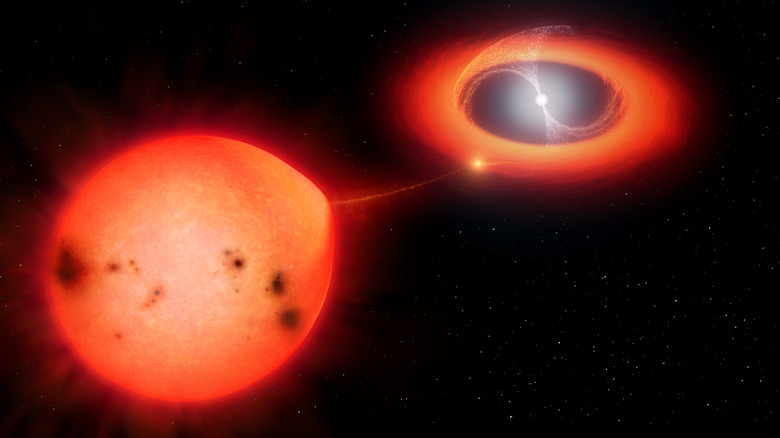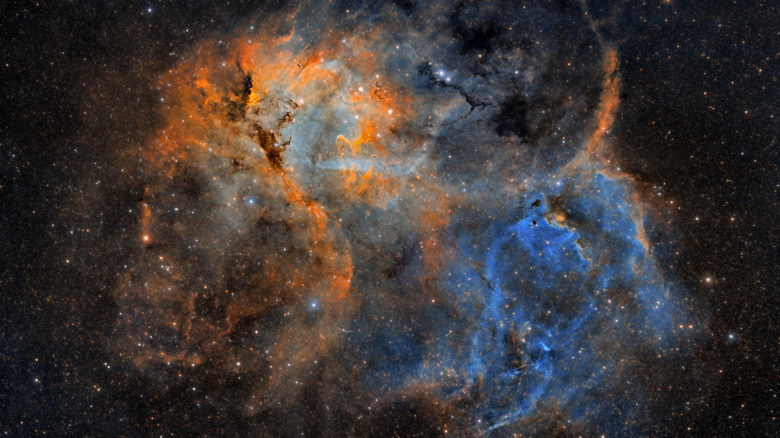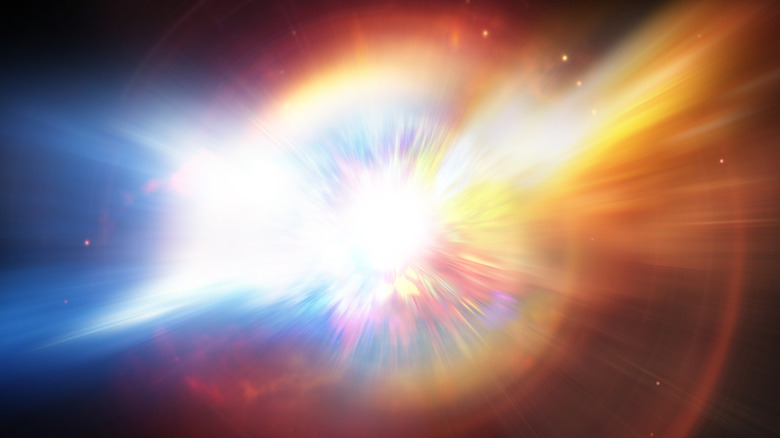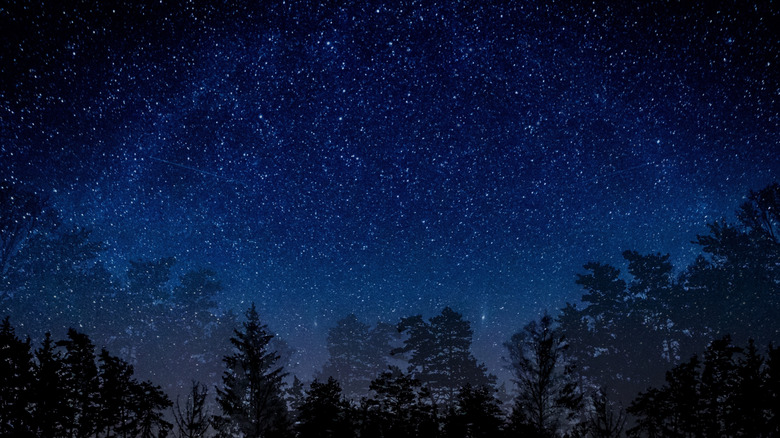Everything You Should Know About The Rare T Coronae Borealis Nova Event
Corona Borealis is hardly the most famous of the constellations in the night sky. It is perhaps best known as the partial namesake of the Hercules-Corona Borealis Great Wall, the largest structure in the known Universe, but on its own, it isn't much to look at. Meaning "northern crown" in Latin, Corona Borealis is a semicircle of mostly dim stars that wouldn't catch your eye on most nights, but in 2025, it's set to become the center of attention for stargazers across the Northern Hemisphere in what could be the brightest nova event of a lifetime.
If you look just off to the side of Corona Borealis, you'll see the black void of space, but there's actually a star there. It's called T Coronae Borealis, also known as T CrB or the Blaze Star, and although it is far too dim to see with the naked eye on most nights, it is set to have a thermonuclear explosion which will temporarily make it one of the brightest objects in the night sky.
How do we know that a celestial explosion is on the horizon? We've been through this before. T Coronae Borealis is a recurrent nova, a star that experiences eruptions on a regular basis. It was first recorded in 1217, and appears to happen at intervals of roughly 80 years. The last nova event was in 1946, and astronomers have already found evidence that another is imminent.
What causes the T Coronae Borealis Nova?
T CrB is a binary star system, meaning it is actually composed of two stars locked in orbit around a common center of gravity. One of these is a white dwarf star, the dense body left behind when a small to medium-sized star burns up all of its fuel. The other star in the system is a red giant, the stage between a main sequence star and a white dwarf, in which a star expands by many times its size.
White dwarves are among the densest objects known to exist in the Universe, and thus exert tremendous gravitational force upon their neighbors. As the stars that make up T CrB orbit each other, the white dwarf pulls so strongly that it actually strips gases away from the surface of the red giant. These stolen gases accumulate around the white dwarf and form a swirling ring known as an accretion disk.
Over the course of decades, the white dwarf takes on more and more material from its red giant neighbor. This causes both the pressure and temperature on the surface of the white dwarf to increase, until they eventually become too much and trigger a massive thermonuclear explosion. The accumulated gases are expelled from the white dwarf in a brilliant flash of light that we will be able to see from Earth with our own naked eyes. Once the explosion subsides, the process will begin again, ramping up to the next nova event.
Novae vs. supernovae
The impending T Coronae Borealis Nova event provides a fantastic example of the difference between a nova and more widely-known supernova. Both terms refer to instances in which stars temporarily emit much more light than they typically do, but they occur under very different circumstances. Novae occur in binary star systems like T CrB due to the gravitational forces between white dwarf stars and red giants. When novae occur repeatedly within the same star system, as in the case of T CrB, it is known as a recurrent nova.
The light of a nova can be as much as 100,000 times brighter than the sun, but even that pales in comparison to supernovae, which can be billions of times brighter than the sun. Supernovae occur under two conditions. Type I supernovae are formed from binary star systems similar to T CrB, except that in the case of a supernova, the explosion is so forceful it actually destroys the white dwarf. Type II supernovae occur when supermassive stars, at least eight times larger than the sun, collapse under their own gravitational force, triggering a massive explosion.
Supernovae are less common than nova because most stars simply aren't massive enough to trigger such a large explosion, but amongst regular novae, T CrB is expected to be one of the brightest nova ever seen, with some astronomers like Bradley Schaefer predicting it could be the "brightest nova of the generation" (via Astronomy).
How much brighter will T Coronae Borealis become?
If you look up into the sky on a normal night, you won't see T Coronae Borealis. It's difficult to get an eye on it even with the aid of a telescope, because the star is 3,000 light years away from Earth and is incredibly dim. Astronomers measure the light intensity of celestial objects using stellar magnitude. On the stellar magnitude scale, the larger the number, the dimmer the object. The brightest object observable in our sky, the sun, has a stellar magnitude of -27. On the other end of the spectrum, the faintest stars visible to the naked eye without light pollution are around +6.5 stellar magnitude.
T CrB has a stellar magnitude of +10, making it far too dim for the naked eye and too dim even for many tools to see. However, when the impending nova event occurs, T CrB will briefly increase to +2 stellar magnitude. This will make it as bright as Polaris, the North Star. However, T CrB is over 2,500 light years further away from Earth than Polaris is, underscoring just how incredibly powerful the light from a nova really is.
When will the nova happen?
Technically speaking, the T Coronae Borealis Nova has already happened. Since the star system is 3,000 light years away from us, we are merely waiting for the broadcast of an event that happened in the days of Ancient Greece. However, astronomers aren't exactly sure when that broadcast will be reaching us. T CrB was first identified by the Irish astronomer John Birmingham when it went nova in 1866. After the system exploded again in 1946, researchers realized it was a recurrent nova, and they subsequently noted that writings from both 1787 and 1217 likely alluded to T CrB as well, suggesting that the system erupts at intervals of approximately 80 years.
The 80-year schedule would suggest that T CrB should go nova again in 2026, but astronomers have warned that it will likely come sooner, based on observations of the system. Before the 1946 nova, T CrB was observed to abruptly get dimmer just before the explosion. In 2023, astronomers announced that T CrB was once again dimming, suggesting an imminent nova. The event was originally expected to occur sometime between April and September of 2024. Of course, that didn't happen, so now the world is left on the edge of its seat awaiting a shining light that could pierce the sky any night now.
How to see the T Coronae Borealis Nova
When T Coronae Borealis goes nova, it will be your only chance to see it for the next 80 years, so you'd better seize the opportunity. The explosion could come any day, so if you're intent on catching it, keep tabs on the news. Once the nova happens, it will only last for a few days before the eight-decade cycle begins again. Fortunately, the explosion will be so bright, that it should be visible to the naked eye even with urban light pollution.
The T CrB nova will be visible from the Northern Hemisphere, and it can be found by looking for the Corona Borealis constellation. You can use the two brightest stars in the Northern Hemisphere — Arcturus and Vega — to guide you. If you draw an imaginary line with your eyes connecting Vega to Arcturus, the Corona Borealis will be right around the center of that line. You should practice finding it before the nova happens. The only way to truly appreciate a nova is to familiarize yourself with the black void it suddenly emerges from. When the T Coronae Borealis Nova finally happens, you'll swear there's a brand new star in the sky.
